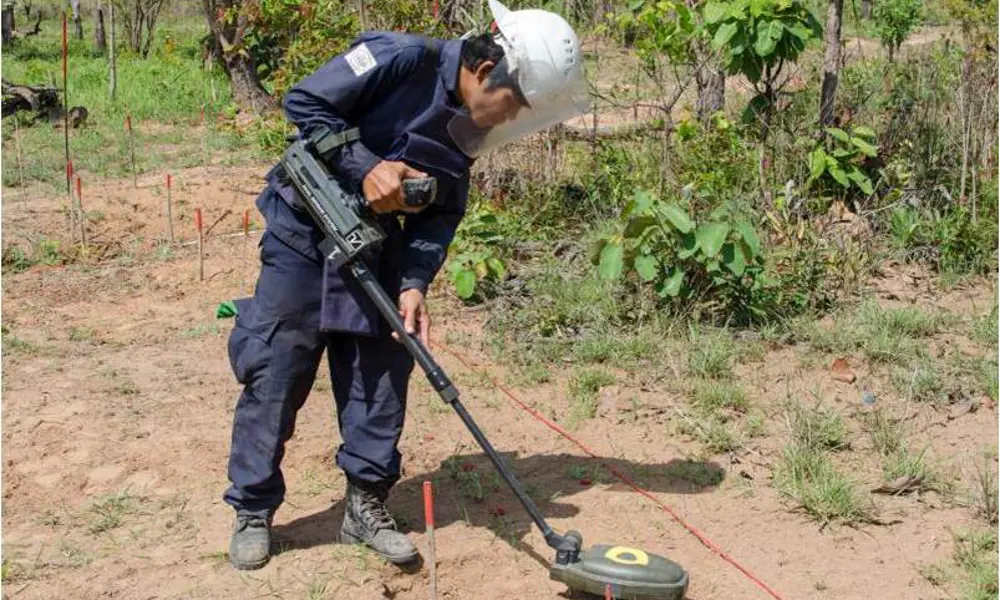
Detecting landmines for a safer world
The indiscriminate use of landmines hit the headlines in 1997, when the media carried photographs of Diana, Princess of Wales, walking through minefields in Angola. Since then, 27 countries have been declared landmine-free, over 51 million stockpiled landmines have been destroyed and the international trade in landmines has ground to a halt. However, more than 60 million people still live with the daily fear of unexploded munitions.
Landmines contaminate some 60 countries, in areas that include jungles, deserts or urban regions. There is no way to know where landmines are: they might be buried or surface-laid, placed by hand or scattered from vehicles or helicopters, in regular or irregular patterns. Furthermore, soil erosion caused by rain can move landmines or cover them. The debris of destroyed buildings in urban environments can also hide devices. Finding landmines is, then, no easy task. Detection equipment needs to work across a wide range of environments, conditions and roles.
There is no way to know where landmines are: they might be buried or surface-laid, placed by hand or scattered from vehicles or helicopters, in regular or irregular patterns. Furthermore, soil erosion caused by rain can move landmines or cover them
Traditionally, humanitarian landmine detectors have used metal detectors that operate at frequencies below 100 kHz. This allows relatively simple and low-cost technology to be used as the basis for detector designs. However, landmine designers have gradually reduced the amount of metal in landmines to make them more difficult to detect. As the metal content in landmines has become smaller, soils that are mineralised (that contain magnetic compounds) cause the detector to generate false alarms and much effort has gone into designs that overcome the effect of soil mineralisation or ‘uncooperative’ soils.
landmine designers have gradually reduced the amount of metal in landmines to make them more difficult to detect. As the metal content in landmines has become smaller, soils that are mineralised (that contain magnetic compounds) cause the detector to generate false alarms
Metallic battlefield debris and shrapnel can also create too many false alarms. For instance, between 1992 and 1998, humanitarian demining in Cambodia excavated over 200 million items, less than 0.3% of which were antipersonnel mines or other explosive devices. Humanitarian deminers need a handheld landmine detector that can reject alarms from small pieces of metal while maintaining the ability to detect minimum-metal landmines.
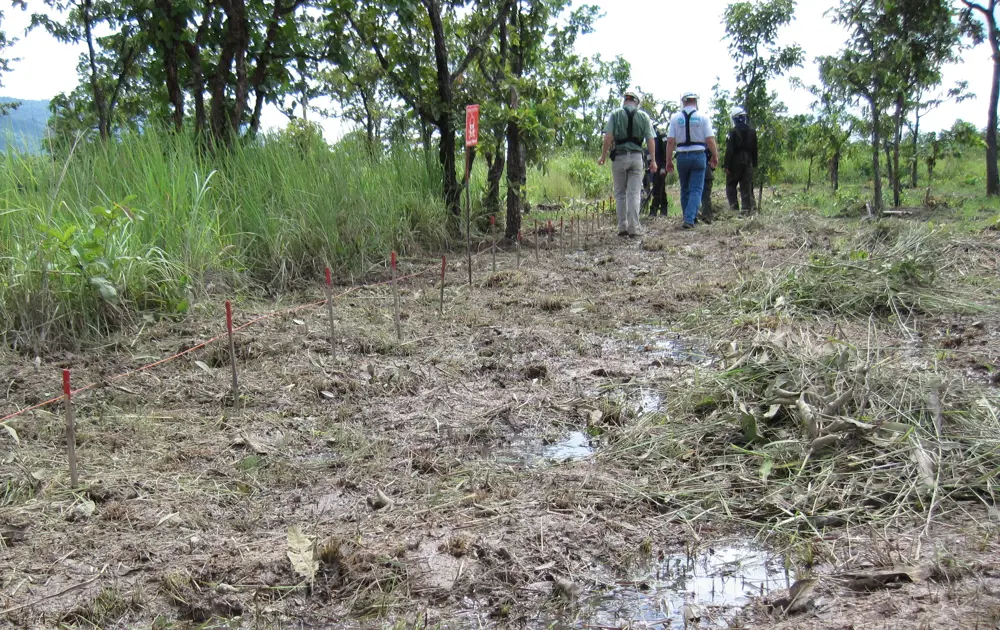
Landmine fields in Cambodia show the challenging environments that detectors need to operate in
Engineering challenge
To overcome these problems, military organisations, universities, industrial research and technology organisations, and private companies have all worked to develop new detectors based on combined metal and radar detectors – so called dual-sensor systems.
Using a range of different metal detector frequencies enables differentiation between various types of metal. For example, it can clearly distinguish the metal in a landmine fuse from a coin [see Distinguishing between metals]. In a similar way, the ground-penetrating radar (GPR) signature can show how the mine’s response to the radar signal differs from the ground and other non-metallic items, such as rocks and roots.
the ground-penetrating radar (GPR) signature can show how the mine’s response to the radar signal differs from the ground and other non-metallic items
Distinguishing between metals
📊 Understanding the inherent characteristics of the landmine through measured information
This diagram shows a composite image containing the captured metal detector and ground-penetrating radar (GPR) spectral information over a series of targets in an experimental trial. The images on the left (a to c) show radar data, and the graphs on the right (d to f) multi-frequency metal detector data. The image in the middle (g) shows the position of four target objects with the GPR data information overlaid. The GPR response is represented using red highlights in the figure, and it is possible to see that these highlights correspond with the known object locations.
The plot shown in (b) is an integrated image of the full GPR depth data. In this image, the radar data from the different depths where the targets were buried have been combined to generate a single, top-down view that contains the responses from every target. This figure shows all four buried targets but the detection of the landmine target is very marginal (the target is a surrogate of a PMA2 landmine, which is a Yugoslavian antipersonnel mine). The images in (a) and (c) show the result of a short-time Fourier transform (STFT) of the radar data for each position over a target. These plots show the spectral content of the signal as a function of time, with the contour lines showing the 25%, 50%, 75% and 95% amplitude levels. These figures demonstrate the richness of the data collected by the prototype dual modality sensor and the possibilities for future developments regarding discrimination and classification algorithms.
The metal detector plots on the right show that each object has different spectroscopic responses. The metal detector responses have two components: one is in-phase with applied signal (known as the real component) and the other is in quadrature (or 90 degrees, known as the imaginary component). Both components are needed to characterise the metal target. For instance, uncooperative soils have a very strong real component and relatively flat imaginary component, whereas minimum metal mines have a step in their real component and peak in their imaginary component at around 10 kHz. These different features can be used to reject the effects of the ground. In addition, different metal objects can be distinguished by the shape of their responses. More conductive objects have the peak in the imaginary response at lower frequencies.
The data above does not represent information in a format that would be presented to an end-user. However, it is very useful in understanding the inherent characteristics of the landmine. Furthermore, the figure emphasises the richness of the measured information as it is representative of the data that can be made available for the development of multi-modal detection, discrimination or classification algorithms.
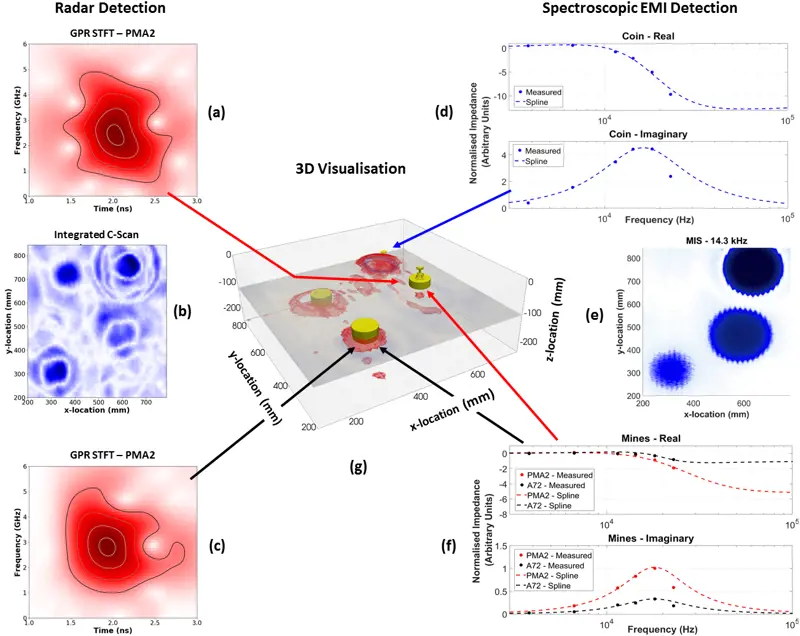
The key to better target recognition lies in understanding and analysing the electromagnetic signatures of landmines over a wide range of frequencies, from those used for both radar, typically a few 100 MHz to several GHz, and metal detection, a few kHz to tens of kHz. A suitable analogy is the vibration of a wine glass when the rim is rubbed. The glass has spectral characteristics that are unique to its size and construction, and will resonate at certain frequencies. While this is an acoustic/vibrational interaction, the same process can be applied electromagnetically.
The relatively small size of worldwide humanitarian demining operations, in terms of the annual sales market for detectors, is a critical aspect that designers and developers have to take into account. While dual-sensor technologies have been developed for military use, they are too expensive for humanitarian demining organisations.
The engineering challenge is to devise affordable mine detectors that humanitarian organisations can use safely and reliably in the field
The humanitarian market for metal detectors is estimated to be around $10 million, with an average sales price of $2,500 per unit, and is served by about five main suppliers. Non-governmental organisations in the field of demining have limited budgets to purchase new technology, which sets the bar for the sales price for new detectors. The market is also too small to support the high costs of developing advanced technologies. The engineering challenge is to devise affordable mine detectors that humanitarian organisations can use safely and reliably in the field. One way in which developers of new mine detectors may achieve this is to exploit the inexpensive electronic components developed for consumer products.
Demining demands physical and mental concentration from the deminers. Making this task easier is the main challenge for the designers of the next generation of equipment. Detectors should ideally weigh less than a kilogram and should automatically adjust to the environment and the user. They should be able to not only detect, but classify types of mine and should separate them from clutter such as bullet cases, metal fragments, tree roots, stones, animal burrows and so on. The equipment must also meet near military standards for shock, vibration, temperature and environmental protection at a price similar to the metal detectors used by the humanitarian demining community today.
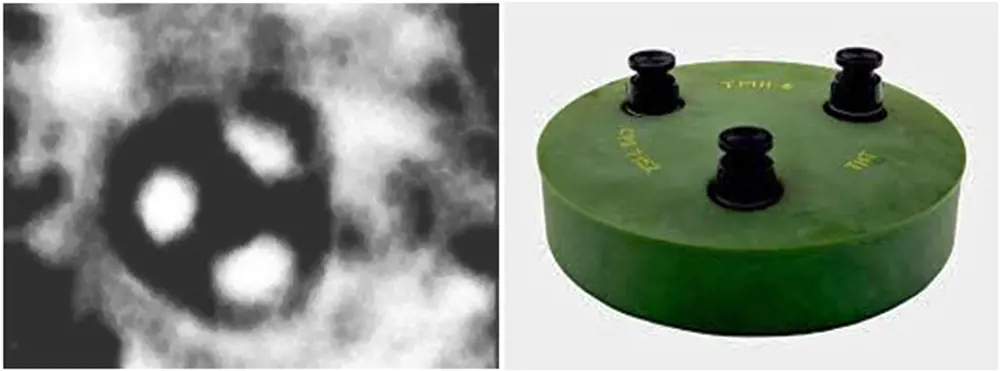
An image generated by ground-penetrating radar (left) of a buried TMA-4 AT landmine (right). Radar images are lower resolution because the wavelengths are comparable with the target © ERA Technology/Cobham
Detection technologies
Existing landmine detection uses a range of technologies: metal detectors, GPR, a combination of the two, radio-frequency quadrupole resonance, microwave and millimetre wave radiometers, thermal imaging, optical methods, vapour detection, X-ray backscatter and acoustic sensors.
Metal detectors are the oldest and mostly widely used detection technology for manual demining. A typical handheld metal detector uses low-frequency electromagnetic induction to detect metal objects at or below the surface. It generates a primary magnetic field, which creates a secondary magnetic field that forms around objects that are magnetic or electrically conductive, such as metal components.
The detectors operate by transmitting and receiving pulsed or continuous electromagnetic waves. Continuous wave detectors produce and monitor magnetic fields continuously to sense disruptions caused by a conductive object’s secondary field. Pulsed detectors transmit an impulse-like magnetic field and use the receiver to monitor the decay of the secondary magnetic fields, caused by the ground and any metal target. The detector’s sensitivity depends on the strength of the magnetic field and the conductive and magnetic properties, mass, shape, and position of the target. For example, copper and aluminium are good conductors and ordinary steel is magnetic making them easy to detect. It is harder to identify stainless steel as it produces a weaker signal because it interacts less with the magnetic field due to its lower electrical conductivity.
deminers would like to be able to ignore harmless metal items so that they can concentrate on explosive devices
Find a better way
💥 The charity negating the effects of mines and improving the safety of local communities
In 2011, Sir Bobby Charlton set up Find a Better Way after seeing the destruction caused by landmines on a visit to Cambodia, feeling that modern technological advances could develop a more efficient way of negating the effects of mines and improving safety and security for local communities whose lives are affected by them.
The charity commits significant funding to research projects at UK universities that are carrying out cutting-edge research into improving the tools available for the safe removal of landmines. It also funds risk-reduction education programmes and humanitarian assistance in areas populated by landmines.
The University of Manchester is currently working on a programme funded by the charity to research and develop new dual-mode metal classification and radar technology that will help improve productivity of landmine clearance.
The humanitarian community’s reliance on metal detectors is down to several factors. First, there is a good understanding of how the detectors work and several companies compete to bring the most effective detectors onto the market. Second, the technology is relatively inexpensive. Third, current procedures are based on ensuring the ground is free of all metal, and while zero-metal mines exist, most have now been removed so they are hardly ever found. So, effective, safe operating procedures and quality controls can be put in place based on the assumption that no metal means no mines. However, metal detectors have the serious limitation of detecting metal clutter such as fragments of shell and bomb cases, so wasting significant time excavating items that are not dangerous. Ideally, deminers would like to be able to ignore harmless metal items so that they can concentrate on explosive devices.
GPR is an effective technique of detecting both landmines and improvised explosive devices (IED). It can detect antipersonnel mines up to depths of 150 millimetres and larger landmines at greater depths, using adaptive signal processing to compensate for varying ground conditions and largely eliminate false returns from the ground surface. As an easy-to-use, low-power, compact device, it can be integrated with a metal detector to form a dual-sensor detector.
GPR is an effective technique of detecting both landmines and improvised explosive devices (IED)
GPR detectors transmit a pulse of energy into the ground and detect the energy scattered back from the buried target. The radiated energy can be either a very short impulse (a nanosecond) or a stepped-frequency continuous waveform with spectral characteristics equivalent to the impulse. The radar transmits over a range of wavelengths that can penetrate the ground. These wavelengths are optimised to achieve good ground penetration while ensuring that the landmine reflects an adequate signal. The signals reflected from a landmine are around one-thousandth to one ten-thousandth of the signal transmitted. This means that sensitive receivers and sophisticated signal processing are required to extract the wanted signal from interference and unwanted targets.
The strength of the received signal depends on the radar cross-section of the target and the losses from the radar signal as it spreads from the transmit antenna, enters the ground, reflects from the target and returns to the receive antenna. The radar cross-section of the target depends on its physical size in comparison to the wavelength of the radar signal. The radar cross-section gets smaller for longer wavelengths whereas the propagation loss in the soil reduces for longer wavelengths. Therefore, the radar designer must choose the wavelengths of operation to optimise detection in terms of target size and soil attenuation.
The strength of the received signal depends on the radar cross-section of the target and the losses from the radar signal as it spreads from the transmit antenna, enters the ground, reflects from the target and returns to the receive antenna
Although some vehicle-mounted radar systems have ranges of several metres, for handheld detectors, the radar antenna beam moves in a known pattern over the surface of the ground, generating an image on a real-time display. It is possible to create a radar image of the landmine but this is very different from an optical image, simply because the wavelengths are not comparable. Optical images are created because the wavelengths of light are smaller than the object and so achieve very high resolution. Radar images of landmines are generated using wavelengths that are comparable with the dimensions of the target, so image resolution is less than an optical image. The soil also acts as a filter and weakens the smaller wavelengths that results in an image that is highly dependent on the propagation characteristics of the ground. In addition, the antenna’s beam pattern spreads widely and this degrades the spatial resolution of the image unless corrected. These are fundamental issues of the physics of propagation that the radar designer needs to understand if it is to detect landmines successfully.
At present, GPR systems do not fully exploit the information available in the reflected signal, which could be used to identify particular types of landmine. This would allow a greater breadth of capability and performance.
Global efforts to ban landmines
📖 The Ottawa Mine Treaty and the Landmine Free 2025 campaign
Implemented just over 20 years ago, the Ottawa Mine Ban Treaty led to a fall in casualties from landmines, the destruction of millions of mines, and a virtual end of their use. Although the majority of the world’s countries have signed the treaty, 33 have not and are stockpiling an estimated 50 million landmines. The general landmine problem arises because, although there are internationally agreed military procedures for deploying and recording the position of minefields and individual landmines, these are often ignored in conflicts where civil wars and insurgencies take place.
In 2014, after 15 years of steady decline, the use of mines has increased in many conflicts and resulted in a rise in casualty numbers. In April 2017, global humanitarian demining charities The HALO Trust and MAG International launched the Landmine Free 2025 campaign to reenergise support for landmine clearance.
Current demining
Dual-sensor systems using both metal detectors and GPR offer distinct advantages over single-mode detectors. This is because GPR does not detect debris and mineralisation from the soil, but both sensors can positively identify landmines, resulting in a reduced false alarm rate compared with that from an individual sensor. The most widely used dual-sensor systems in the world include the US Army’s Handheld Standoff Mine Detection System (HSTAMIDS) and the Anglo-German Vallon – Cobham VMR3 Minehound.
HSTAMIDS became the US Army’s standard mine detector in 2006. It combines GPR with a highly sensitive metal detector that uses advanced data-fusion algorithms, which combine the output from both the metal detector and GPR to give a single indication of the possible presence of a threat. This allows it to reliably find landmines, without detecting metallic clutter.
HSTAMIDS became the US Army’s standard mine detector in 2006
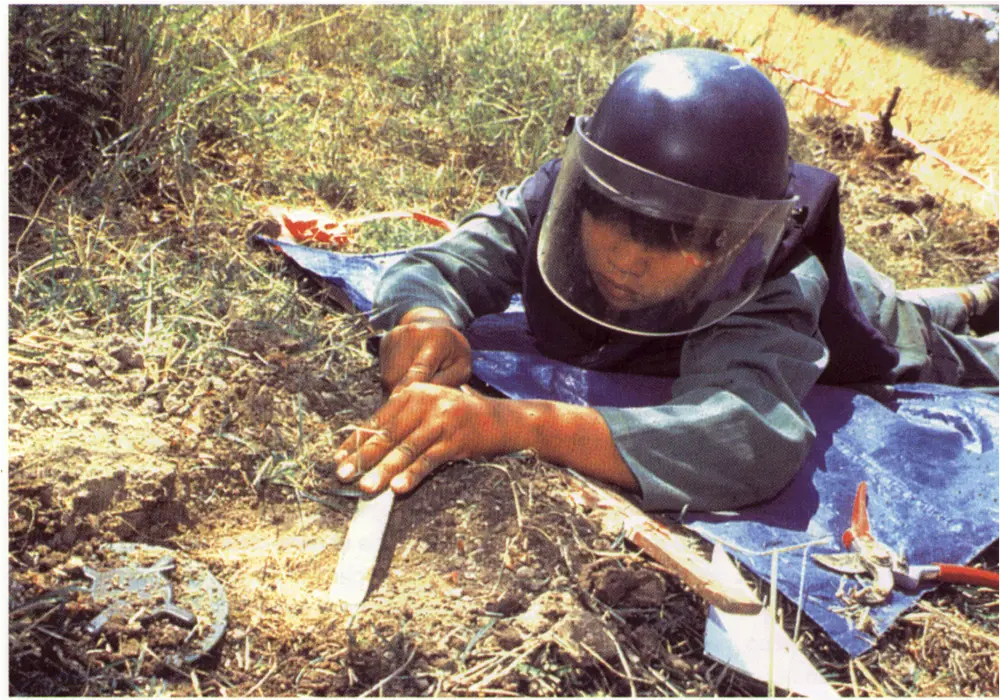
Humanitarian demining is a thorough and time-intensive process, and the standards of the clearance operation and its cost-effectiveness are the keys to successful operation © UN
The GPR section in HSTAMIDS is based on a wideband, stepped-frequency radar transceiver. The search head has one transmit and two receive antennas. The transmit antenna produces continuous wave, low-power radar. As the search head passes over the surface and the radar signal encounters resistance in the soil, some energy scatters back to the receiving antennas where data-fusion algorithms process the signal to optimise detection. The metal detector sensor incorporates compensation for soils that have high magnetic susceptibility and provides high-sensitivity detection of buried metal objects. Its unique data-fusion algorithms allow the operator to effectively discriminate between real mines and metallic clutter.
While it is primarily military operations that use HSTAMIDS, the US Humanitarian Demining Research and Development Program and The HALO Trust led initiatives to evaluate the technology in humanitarian operations. A field evaluation in Cambodia between March 2006 and June 2008 assessed the performance of 12 HSTAMIDS in field conditions, which included a wide variety of soils, minimum-metal mines and high levels of metallic clutter. The evaluation, with local deminers operating the detectors, cleared 604,375 square metres of land, detecting more than 1.4 million objects. It found 5,610 mines, with 96.5% of the clutter correctly identified. Following the success of the evaluation, The HALO Trust began using an additional 50 HSTAMIDS globally.
In 2001, engineering consultancy ERA Technology began the development in the UK of the dual-sensor Minehound detector for humanitarian demining. It aimed to simplify traditional GPR systems and produce a design that deminers, who were more familiar with the operation of metal detectors, could work with easily. Although much of the complexity of the operation of the radar was removed from the operator, flexibility of operation was still retained. This flexibility is essential to allow the operators to adapt to variability of soil and environmental conditions by changing key operating parameters. The design also avoided an over-reliance on predetermined software algorithms that assumed the operator would be incapable of interpreting instrument readings.
This flexibility is essential to allow the operators to adapt to variability of soil and environmental conditions by changing key operating parameters
ERA Technology’s Vallon – Cobham VMR3 Minehound is an advanced technology, dual-sensor metal detector and GPR system, designed specifically for demining operations. It communicates with the operator through audio signals whereby the depth of the target is related to audio pitch and the amplitude to the strength of the reflected signal, which harnesses the ability of a human brain to process complex information in the same way as listening to music. The system initially operates in metal detector mode, where all metal threats are noted, before using GPR to confirm the presence of a threat. The audio from the metal detector provides accurate information on the position of the item and an indication of metal mass. The GPR provides accurate information on the position, depth and radar cross-section of the target. It responds to even the smallest buried mines while its specially designed antenna ignores small metal fragments, which results in the rejection of false alarms caused by metallic clutter. The operator can choose to work with the metal detector or the GPR only or with both systems simultaneously, giving flexibility in a variety of different operational situations such as ground types, surface conditions and expected types of threat.
The UK’s Department for International Development sponsored initial trials in Bosnia, Cambodia and Angola from 2005 to 2006. In August 2010, The HALO Trust began Minehound detector trials in Cambodia. The programme cleared 573,109 square metres. It detected more than 660,000 objects, 845 of which were landmines. In 2013, 95% of the metal clutter was identified.
Future development
Engineers now have a much better understanding of how metal targets respond to an applied alternating magnetic field, by representing the response of the metal target with its equivalent ‘tensor signature’. The tensor signature offers a concise mathematical formula, suitable for real-time processing that describes this response. For instance, magnetic objects respond differently to non-magnetic objects, long thin objects have a more directional response than more spherically shaped objects, and smaller objects tend to respond more at higher frequencies. This suggests that multi-frequency receivers could determine the tensor signature of the target and not just detect, but also characterise and classify the targets to distinguish between shapes, sizes and material composition to further counter the problem of metallic clutter.
Recent progress in electronics and communications has expanded the availability of cheaper microwave components. The circuitry required for inexpensive and advanced stepped-frequency GPR is similar to that used in modern communication systems, such as high-speed telecommunications, suggesting that it may be possible to develop cheaper, improved performance GPR that is tailored specifically to humanitarian demining.
The HALO Trust has shown in Cambodia that using a metal detector as a primary detector and using GPR to check all the alarms produced by the metal detector can have a dramatic impact on false alarm rates
The HALO Trust has shown in Cambodia that using a metal detector as a primary detector and using GPR to check all the alarms produced by the metal detector can have a dramatic impact on false alarm rates. A low-cost GPR could have significant impact as a confirmation tool, while being within the budgets of most humanitarian organisations.
A low-cost, dual-sensor metal detector and GPR, or a low-cost standalone GPR, would improve productivity within a year or two of widespread implementation. This improved productivity and reduction in person hours needed to clear contaminated minefields would cover the cost of the initial investment. Over the years, this would reduce the cost per cleared square metre.
Over the last 20 years, significant steps forward have been made to rid the world of landmines. However, more action is needed. If this goal is to be achieved, a step change will be needed in clearance rates, which requires significant investment to ensure that deminers have access to the best available technology to undertake their arduous and dangerous work.
***
This article has been adapted from "Detecting landmines for a safer world", which originally appeared in the print edition of Ingenia 75 (June 2018).
Contributors
Professor Anthony Peyton has been Professor of Electromagnetic Tomography Systems at the University of Manchester for the past 14 years. He specialises in research on applying electromagnetic inspection systems for a broad range of applications, including non-destructive testing and metal detection.
v is a Royal Academy of Engineering Visiting Professor at the University of Manchester, and a Fellow of both the Institute of Electrical and Electronics Engineers and the Institution of Engineering and Technology. He has published over 120 technical papers, and several books on sensors for security and counter terrorism.
Keep up-to-date with Ingenia for free
SubscribeRelated content
Electricals & electronics
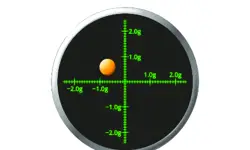
Accelerometers
Used in earthquake measurements, laptops, planes and even in stargazing apps, today’s accelerometers are much smaller than when they were first developed in 1927. Find out how they detect movement and vibration.

How to maximise loudspeaker quality
Ingenia asked Dr Jack Oclee-Brown, Head of Acoustics at KEF Audio, to outline the considerations that audio engineers need to make when developing high-quality speakers.
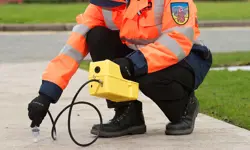
Cable fault locator
The winner of the Institute of Engineering and Technology’s 2014 Innovation Award was EA Technology’s CableSnifferTM, which uses a probe and chemical sensing technology to identify faults, saving energy companies millions of pounds each year.

High speed evolution
In December 2010, Eurostar International Ltd awarded a contract for 10 new high speed trains to Siemens. The company has used a system developed over decades to maximise the performance and passenger-carrying ability of its 320km/h trains.
Other content from Ingenia
Quick read

- Environment & sustainability
- Opinion
A young engineer’s perspective on the good, the bad and the ugly of COP27

- Environment & sustainability
- Issue 95
How do we pay for net zero technologies?
Quick read

- Transport
- Mechanical
- How I got here
Electrifying trains and STEMAZING outreach

- Civil & structural
- Environment & sustainability
- Issue 95